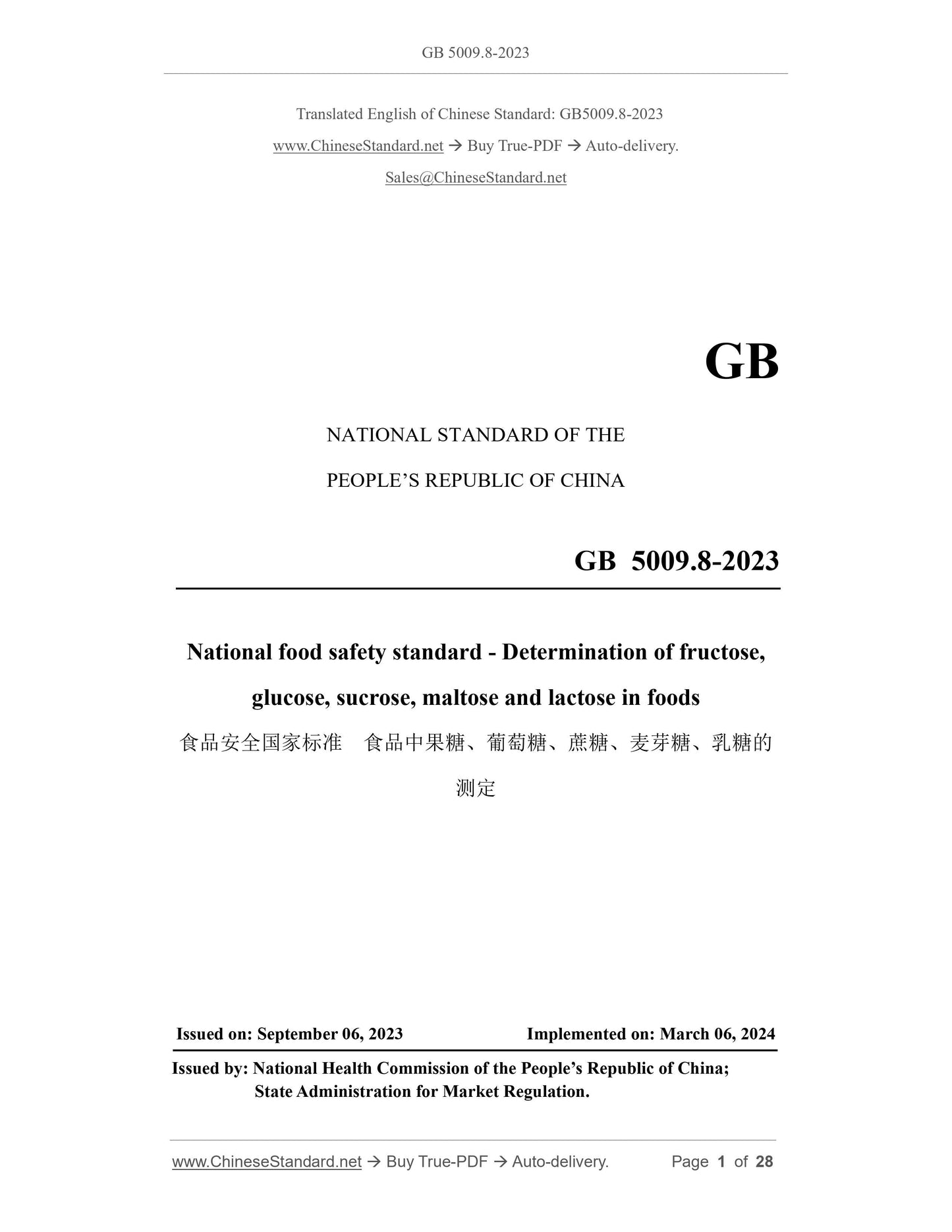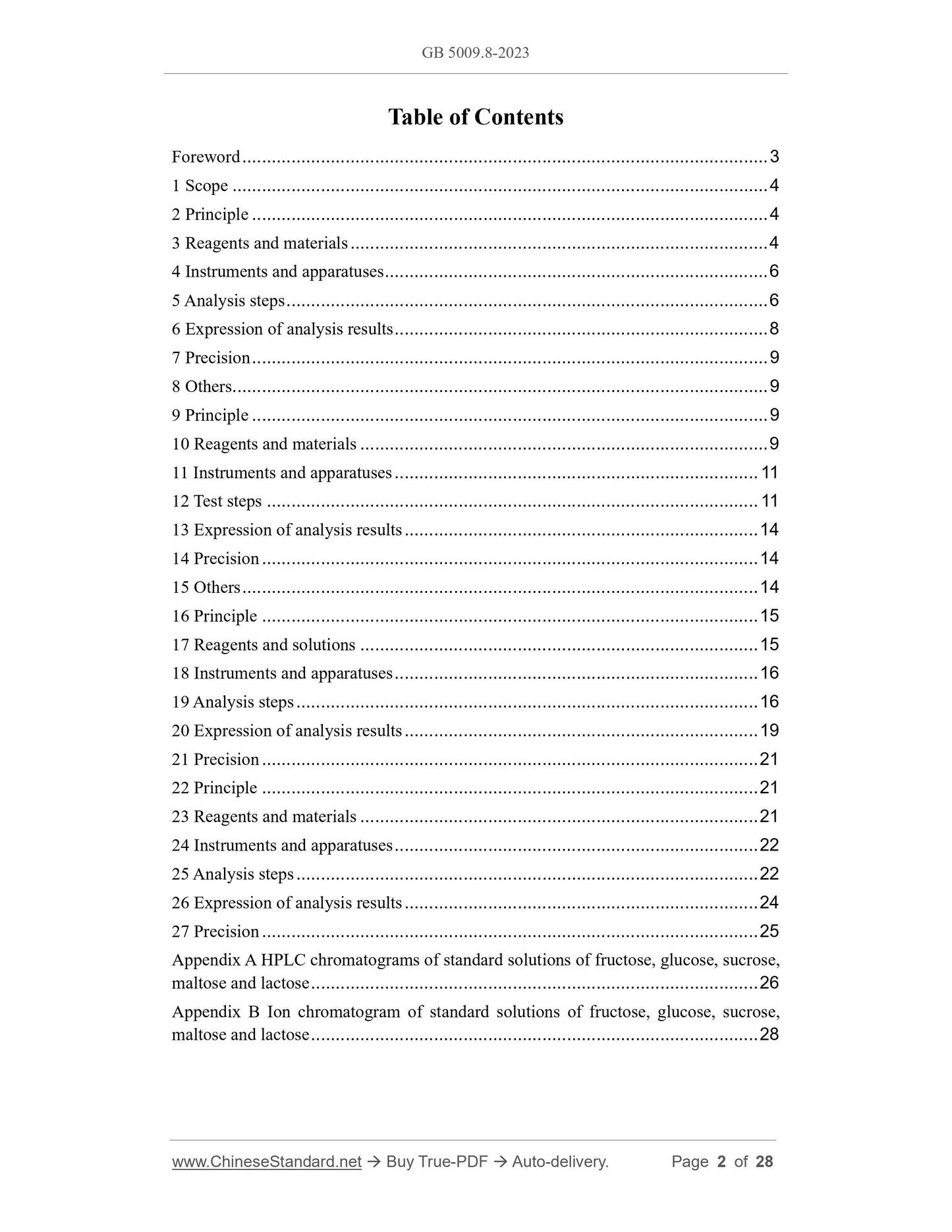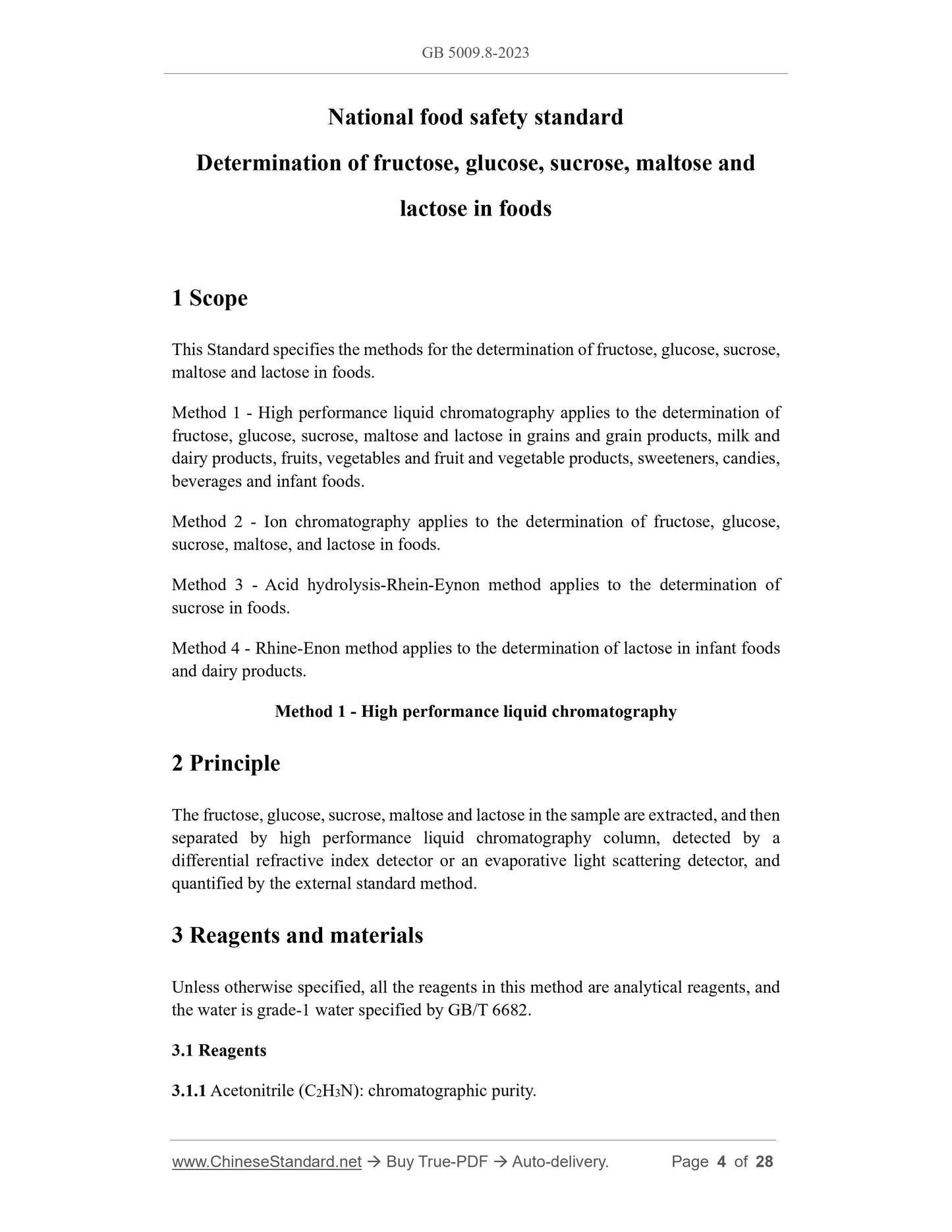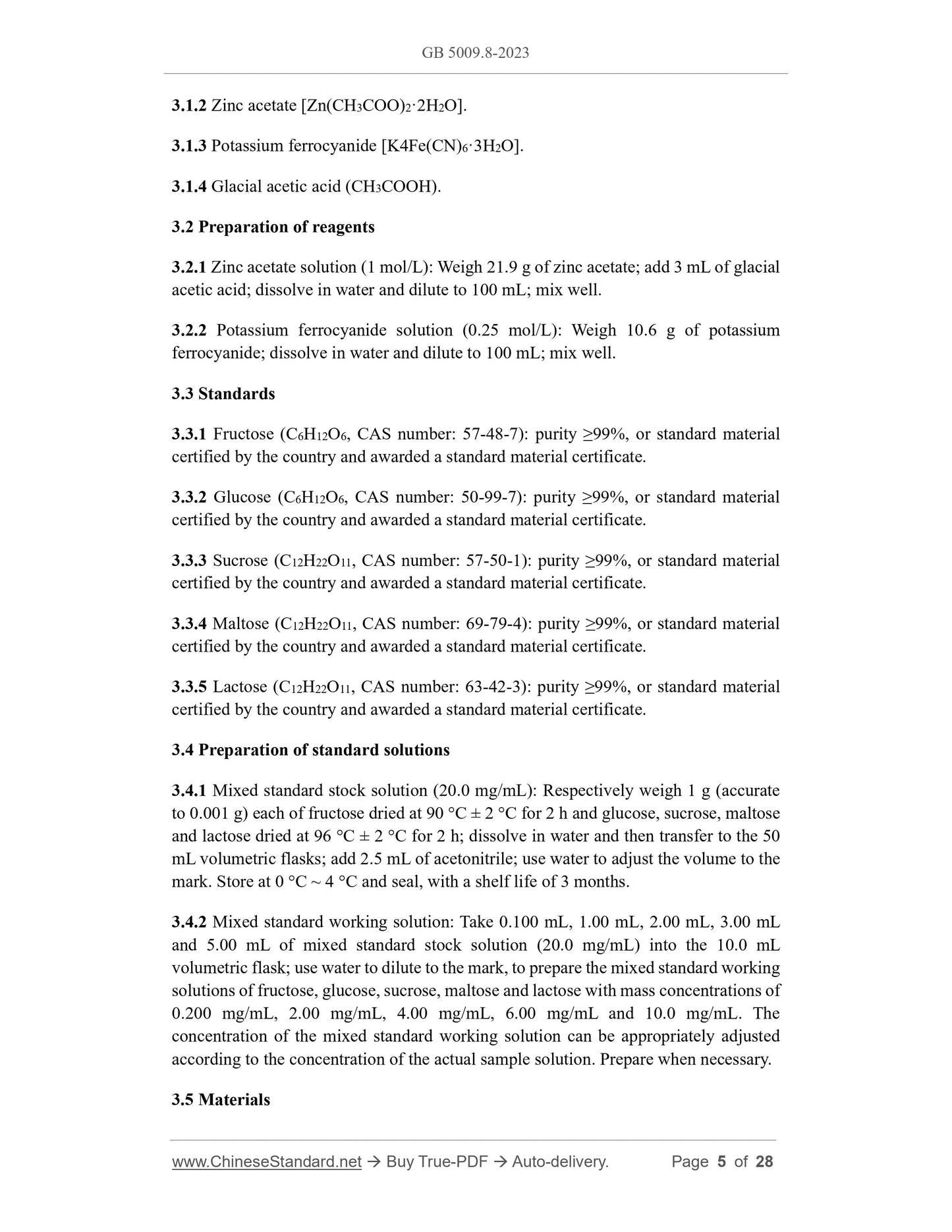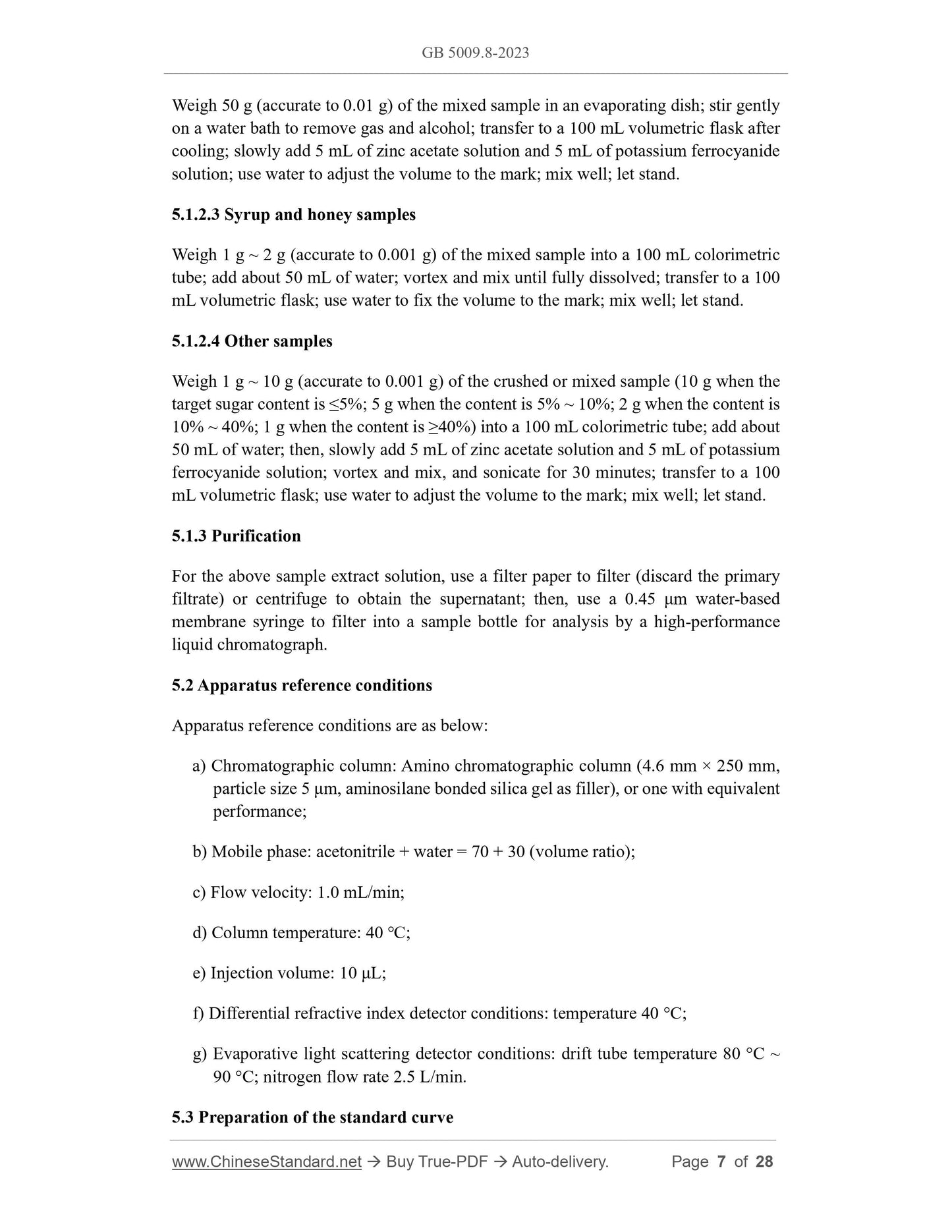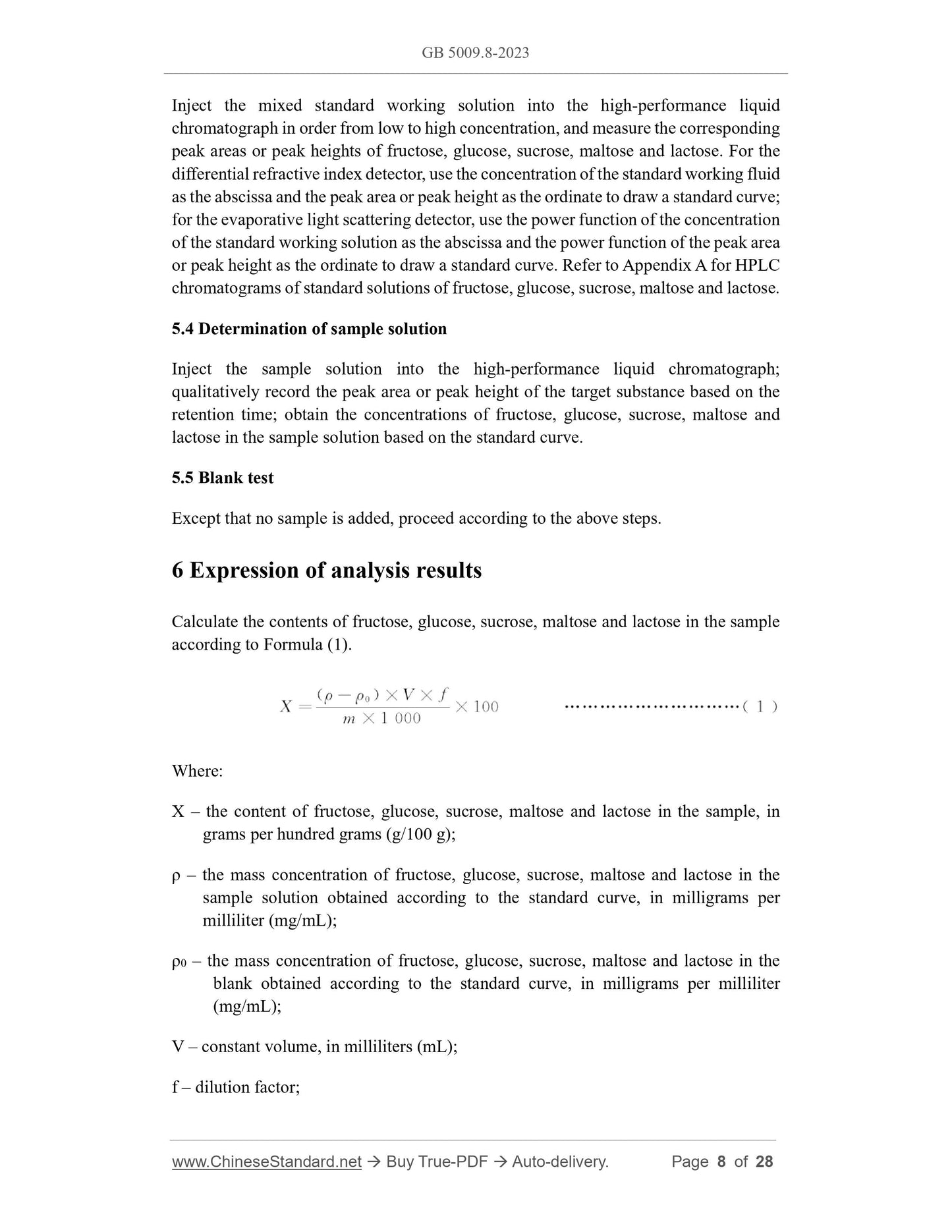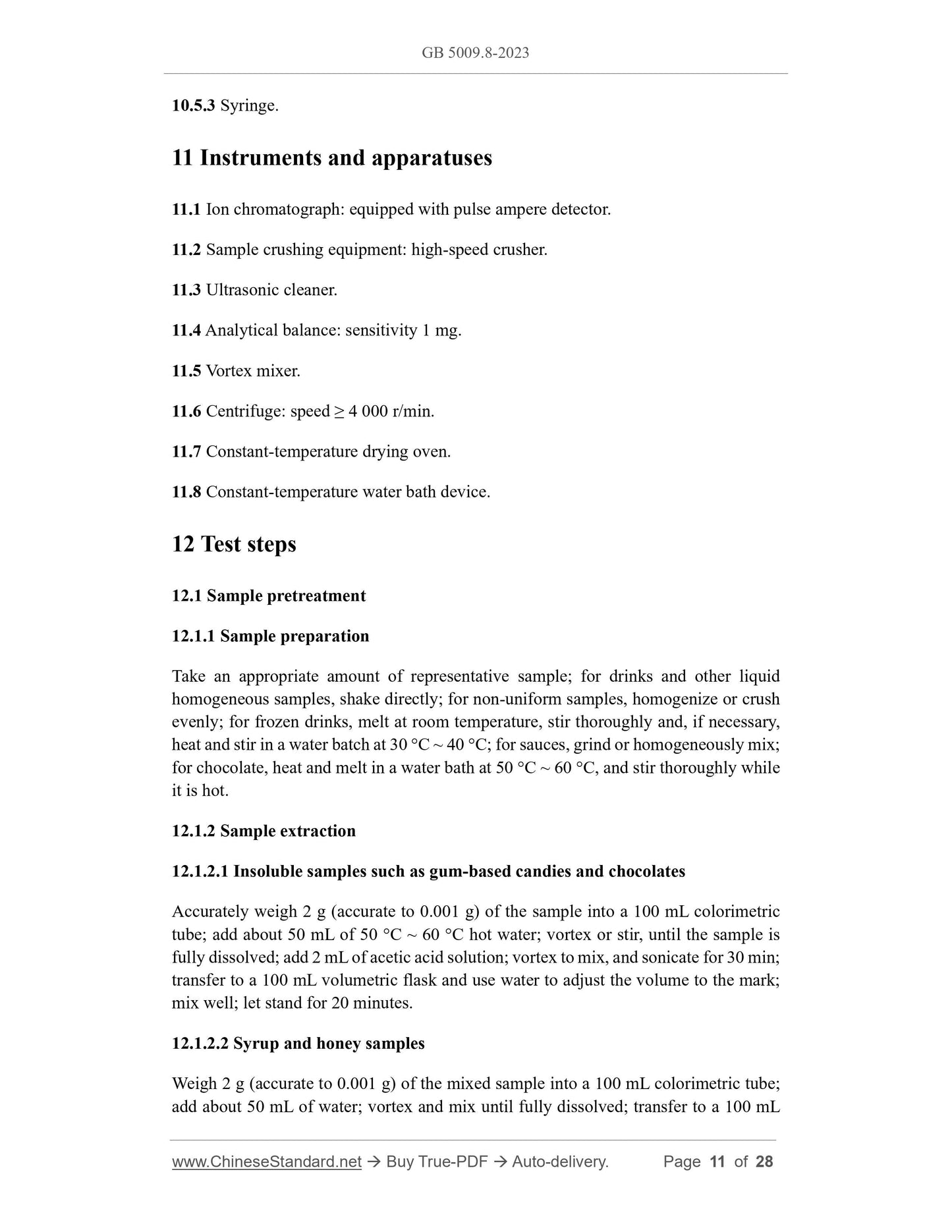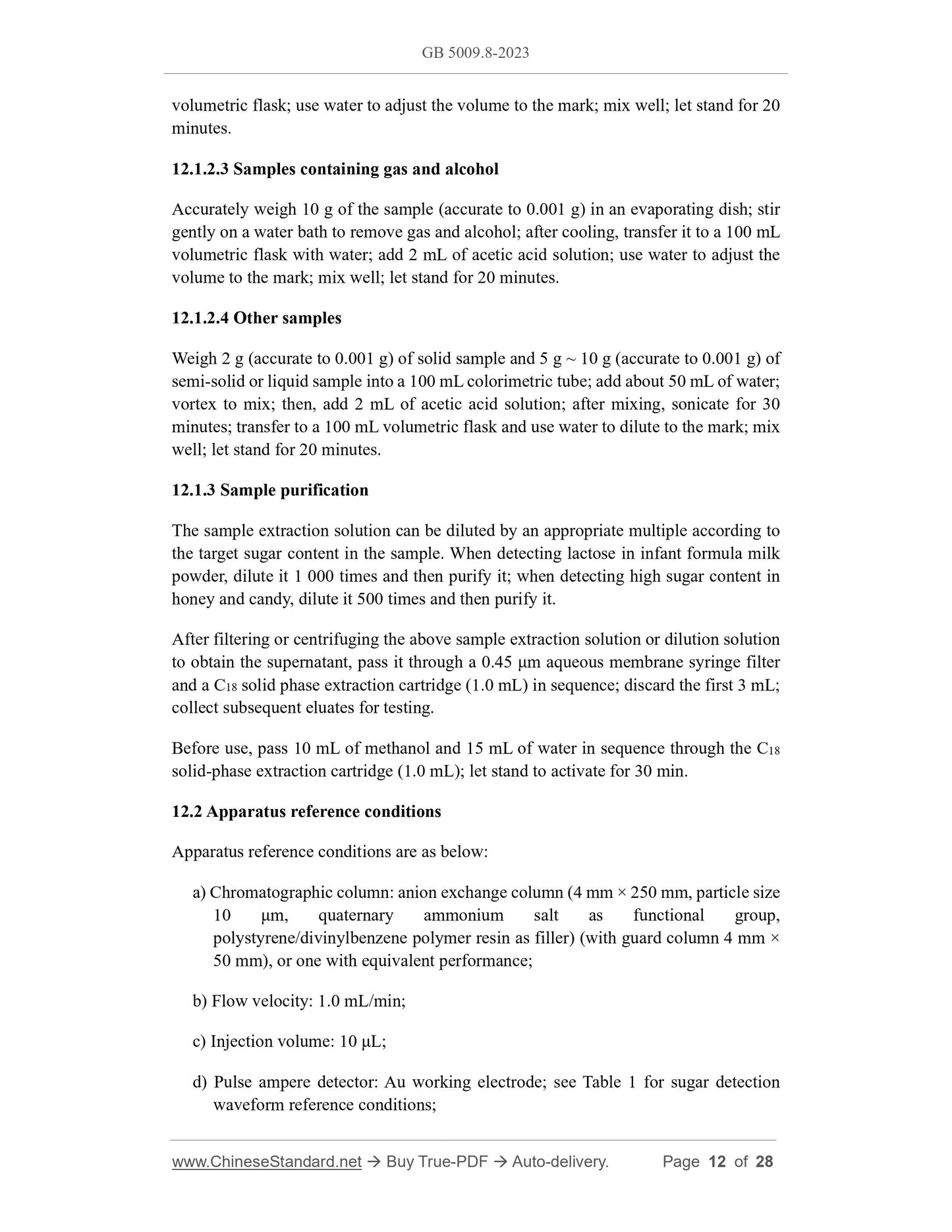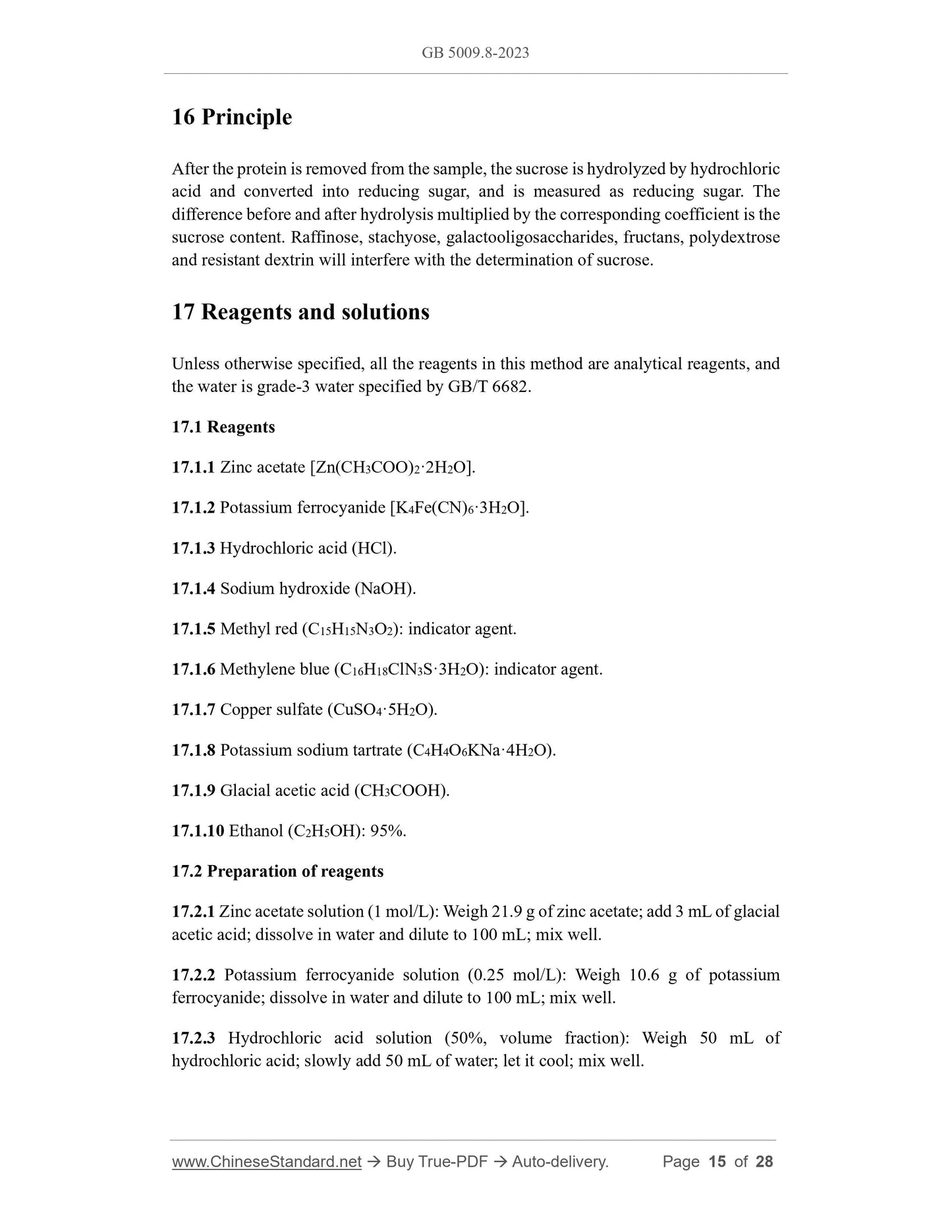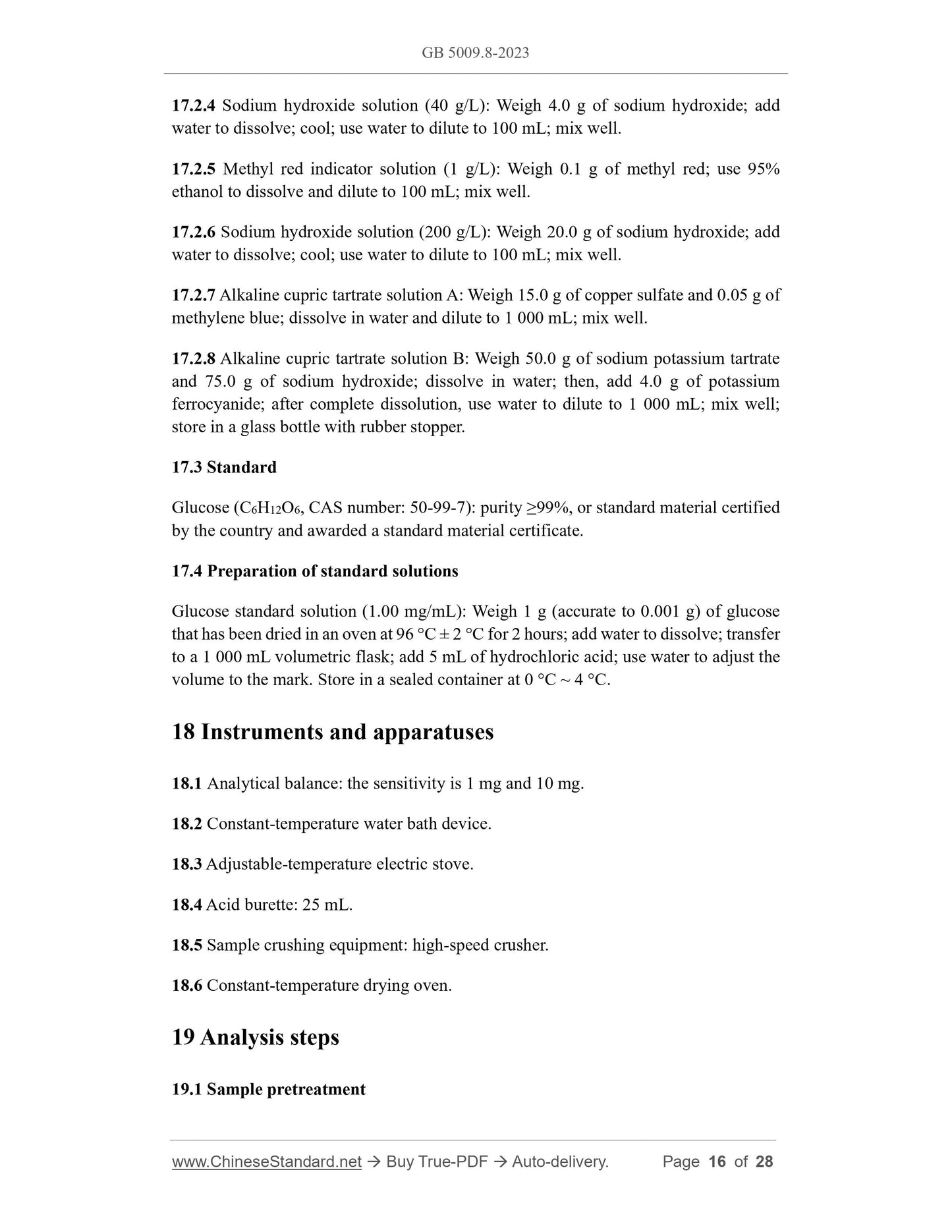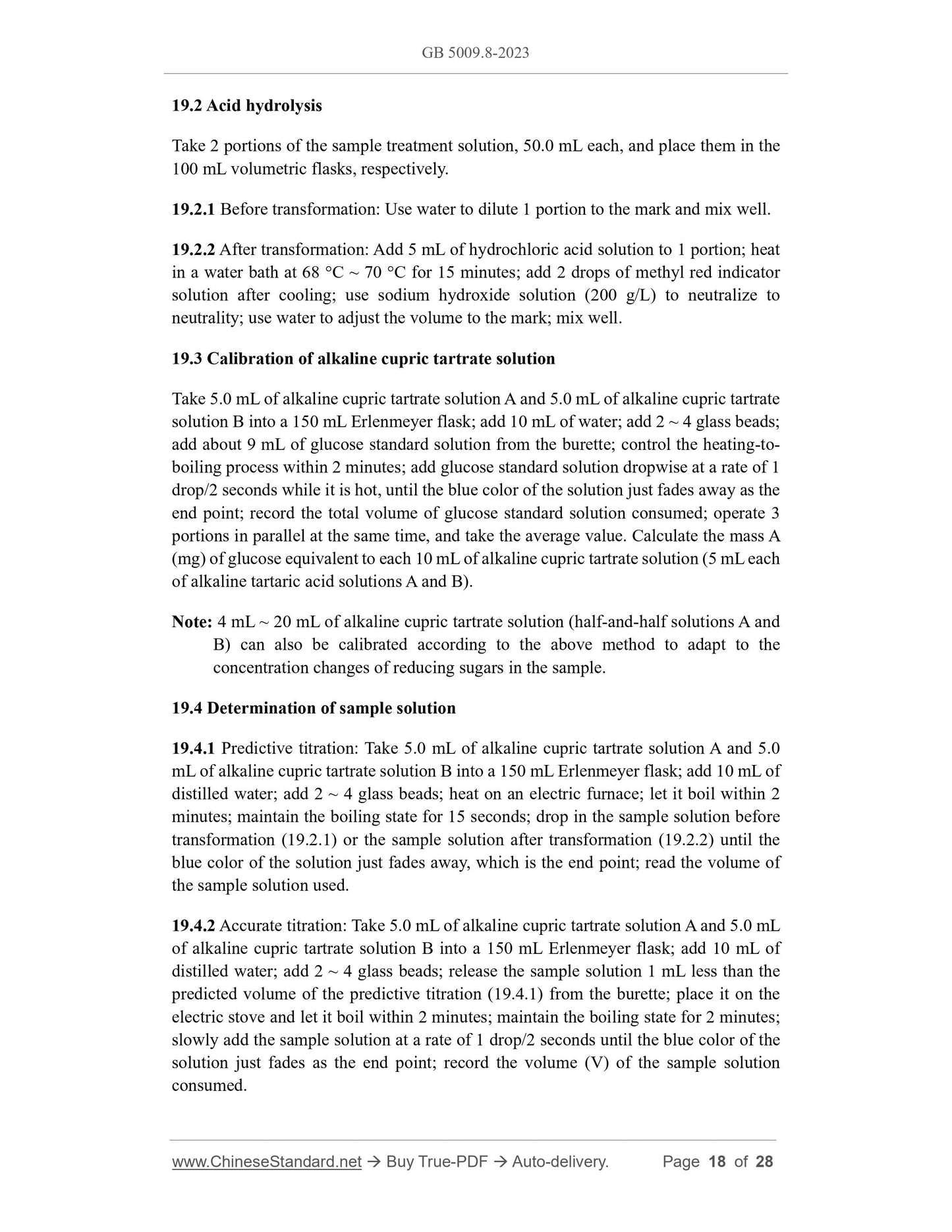1
/
of
12
www.ChineseStandard.us -- Field Test Asia Pte. Ltd.
GB 5009.8-2023 English PDF
GB 5009.8-2023 English PDF
Regular price
$335.00
Regular price
Sale price
$335.00
Unit price
/
per
Shipping calculated at checkout.
Couldn't load pickup availability
GB 5009.8-2023: National food safety standard - Determination of fructose, glucose, sucrose, maltose and lactose in foods
Delivery: 9 seconds. Download (& Email) true-PDF + Invoice.
Get Quotation: Click GB 5009.8-2023 (Self-service in 1-minute)
Historical versions (Master-website): GB 5009.8-2023
Preview True-PDF (Reload/Scroll-down if blank)
GB 5009.8-2023
GB
NATIONAL STANDARD OF THE
PEOPLE’S REPUBLIC OF CHINA
National food safety standard - Determination of fructose,
glucose, sucrose, maltose and lactose in foods
ISSUED ON. SEPTEMBER 06, 2023
IMPLEMENTED ON. MARCH 06, 2024
Issued by. National Health Commission of the People’s Republic of China;
State Administration for Market Regulation.
Table of Contents
Foreword... 3
1 Scope... 4
2 Principle... 4
3 Reagents and materials... 4
4 Instruments and apparatuses... 6
5 Analysis steps... 6
6 Expression of analysis results... 8
7 Precision... 9
8 Others... 9
9 Principle... 9
10 Reagents and materials... 9
11 Instruments and apparatuses... 11
12 Test steps... 11
13 Expression of analysis results... 14
14 Precision... 14
15 Others... 14
16 Principle... 15
17 Reagents and solutions... 15
18 Instruments and apparatuses... 16
19 Analysis steps... 16
20 Expression of analysis results... 19
21 Precision... 21
22 Principle... 21
23 Reagents and materials... 21
24 Instruments and apparatuses... 22
25 Analysis steps... 22
26 Expression of analysis results... 24
27 Precision... 25
Appendix A HPLC chromatograms of standard solutions of fructose, glucose, sucrose,
maltose and lactose... 26
Appendix B Ion chromatogram of standard solutions of fructose, glucose, sucrose,
maltose and lactose... 28
National food safety standard
Determination of fructose, glucose, sucrose, maltose and
lactose in foods
1 Scope
This Standard specifies the methods for the determination of fructose, glucose, sucrose,
maltose and lactose in foods.
Method 1 - High performance liquid chromatography applies to the determination of
fructose, glucose, sucrose, maltose and lactose in grains and grain products, milk and
dairy products, fruits, vegetables and fruit and vegetable products, sweeteners, candies,
beverages and infant foods.
Method 2 - Ion chromatography applies to the determination of fructose, glucose,
sucrose, maltose, and lactose in foods.
Method 3 - Acid hydrolysis-Rhein-Eynon method applies to the determination of
sucrose in foods.
Method 4 - Rhine-Enon method applies to the determination of lactose in infant foods
and dairy products.
Method 1 - High performance liquid chromatography
2 Principle
The fructose, glucose, sucrose, maltose and lactose in the sample are extracted, and then
separated by high performance liquid chromatography column, detected by a
differential refractive index detector or an evaporative light scattering detector, and
quantified by the external standard method.
3 Reagents and materials
Unless otherwise specified, all the reagents in this method are analytical reagents, and
the water is grade-1 water specified by GB/T 6682.
3.1 Reagents
3.1.1 Acetonitrile (C2H3N). chromatographic purity.
3.1.2 Zinc acetate [Zn(CH3COO)2·2H2O].
3.1.3 Potassium ferrocyanide [K4Fe(CN)6·3H2O].
3.1.4 Glacial acetic acid (CH3COOH).
3.2 Preparation of reagents
3.2.1 Zinc acetate solution (1 mol/L). Weigh 21.9 g of zinc acetate; add 3 mL of glacial
acetic acid; dissolve in water and dilute to 100 mL; mix well.
3.2.2 Potassium ferrocyanide solution (0.25 mol/L). Weigh 10.6 g of potassium
ferrocyanide; dissolve in water and dilute to 100 mL; mix well.
3.3 Standards
3.3.1 Fructose (C6H12O6, CAS number. 57-48-7). purity ≥99%, or standard material
certified by the country and awarded a standard material certificate.
3.3.2 Glucose (C6H12O6, CAS number. 50-99-7). purity ≥99%, or standard material
certified by the country and awarded a standard material certificate.
3.3.3 Sucrose (C12H22O11, CAS number. 57-50-1). purity ≥99%, or standard material
certified by the country and awarded a standard material certificate.
3.3.4 Maltose (C12H22O11, CAS number. 69-79-4). purity ≥99%, or standard material
certified by the country and awarded a standard material certificate.
3.3.5 Lactose (C12H22O11, CAS number. 63-42-3). purity ≥99%, or standard material
certified by the country and awarded a standard material certificate.
3.4 Preparation of standard solutions
3.4.1 Mixed standard stock solution (20.0 mg/mL). Respectively weigh 1 g (accurate
to 0.001 g) each of fructose dried at 90 °C ± 2 °C for 2 h and glucose, sucrose, maltose
and lactose dried at 96 °C ± 2 °C for 2 h; dissolve in water and then transfer to the 50
mL volumetric flasks; add 2.5 mL of acetonitrile; use water to adjust the volume to the
mark. Store at 0 °C ~ 4 °C and seal, with a shelf life of 3 months.
3.4.2 Mixed standard working solution. Take 0.100 mL, 1.00 mL, 2.00 mL, 3.00 mL
and 5.00 mL of mixed standard stock solution (20.0 mg/mL) into the 10.0 mL
volumetric flask; use water to dilute to the mark, to prepare the mixed standard working
solutions of fructose, glucose, sucrose, maltose and lactose with mass concentrations of
0.200 mg/mL, 2.00 mg/mL, 4.00 mg/mL, 6.00 mg/mL and 10.0 mg/mL. The
concentration of the mixed standard working solution can be appropriately adjusted
according to the concentration of the actual sample solution. Prepare when necessary.
3.5 Materials
Weigh 50 g (accurate to 0.01 g) of the mixed sample in an evaporating dish; stir gently
on a water bath to remove gas and alcohol; transfer to a 100 mL volumetric flask after
cooling; slowly add 5 mL of zinc acetate solution and 5 mL of potassium ferrocyanide
solution; use water to adjust the volume to the mark; mix well; let stand.
5.1.2.3 Syrup and honey samples
Weigh 1 g ~ 2 g (accurate to 0.001 g) of the mixed sample into a 100 mL colorimetric
tube; add about 50 mL of water; vortex and mix until fully dissolved; transfer to a 100
mL volumetric flask; use water to fix the volume to the mark; mix well; let stand.
5.1.2.4 Other samples
Weigh 1 g ~ 10 g (accurate to 0.001 g) of the crushed or mixed sample (10 g when the
target sugar content is ≤5%; 5 g when the content is 5% ~ 10%; 2 g when the content is
10% ~ 40%; 1 g when the content is ≥40%) into a 100 mL colorimetric tube; add about
50 mL of water; then, slowly add 5 mL of zinc acetate solution and 5 mL of potassium
ferrocyanide solution; vortex and mix, and sonicate for 30 minutes; transfer to a 100
mL volumetric flask; use water to adjust the volume to the mark; mix well; let stand.
5.1.3 Purification
For the above sample extract solution, use a filter paper to filter (discard the primary
filtrate) or centrifuge to obtain the supernatant; then, use a 0.45 μm water-based
membrane syringe to filter into a sample bottle for analysis by a high-performance
liquid chromatograph.
5.2 Apparatus reference conditions
Apparatus reference conditions are as below.
a) Chromatographic column. Amino chromatographic column (4.6 mm × 250 mm,
particle size 5 μm, aminosilane bonded silica gel as filler), or one with equivalent
performance;
b) Mobile phase. acetonitrile + water = 70 + 30 (volume ratio);
c) Flow velocity. 1.0 mL/min;
d) Column temperature. 40 ℃;
e) Injection volume. 10 μL;
f) Differential refractive index detector conditions. temperature 40 °C;
g) Evaporative light scattering detector conditions. drift tube temperature 80 °C ~
90 °C; nitrogen flow rate 2.5 L/min.
5.3 Preparation of the standard curve
Inject the mixed standard working solution into the high-performance liquid
chromatograph in order from low to high concentration, and measure the corresponding
peak areas or peak heights of fructose, glucose, sucrose, maltose and lactose. For the
differential refractive index detector, use the concentration of the standard working fluid
as the abscissa and the peak area or peak height as the ordinate to draw a standard curve;
for the evaporative light scattering detector, use the power function of the concentration
of the standard working solution as the abscissa and the power function of the peak area
or peak height as the ordinate to draw a standard curve. Refer to Appendix A for HPLC
chromatograms of standard solutions of fructose, glucose, sucrose, maltose and lactose.
5.4 Determination of sample solution
Inject the sample solution into the high-performance liquid chromatograph;
qualitatively record the peak area or peak height of the target substance based on the
retention time; obtain the concentrations of fructose, glucose, sucrose, maltose and
lactose in the sample solution based on the standard curve.
5.5 Blank test
Except that no sample is added, proceed according to the above steps.
6 Expression of analysis results
Calculate the contents of fructose, glucose, sucrose, maltose and lactose in the sample
according to Formula (1).
Where.
X – the content of fructose, glucose, sucrose, maltose and lactose in the sample, in
grams per hundred grams (g/100 g);
ρ – the mass concentration of fructose, glucose, sucrose, maltose and lactose in the
sample solution obtained according to the standard curve, in milligrams per
milliliter (mg/mL);
ρ0 – the mass concentration of fructose, glucose, sucrose, maltose and lactose in the
blank obtained according to the standard curve, in milligrams per milliliter
(mg/mL);
V – constant volume, in milliliters (mL);
f – dilution factor;
10.2.2 Acetic acid solution (3%, volume fraction). Measure 3 mL of glacial acetic acid;
use water to dilute to 100 mL; mix well.
10.3 Standards
10.3.1 Fructose (C6H12O6, CAS number. 57-48-7). purity ≥99%, or standard material
certified by the country and awarded a standard material certificate.
10.3.2 Glucose (C6H12O6, CAS number. 50-99-7). purity ≥99%, or standard material
certified by the country and awarded a standard material certificate.
10.3.3 Sucrose (C12H22O11, CAS number. 57-50-1). purity ≥99%, or standard material
certified by the country and awarded a standard material certificate.
10.3.4 Maltose (C12H22O11, CAS number. 69-79-4). purity ≥99%, or standard material
certified by the country and awarded a standard material certificate.
10.3.5 Lactose (C12H22O11, CAS number. 63-42-3). purity ≥99%, or standard material
certified by the country and awarded a standard material certificate.
10.4 Preparation of standard solution
10.4.1 Mixed standard stock solution (10.0 mg/mL). Weigh 1 g (accurate to 0.001 g)
each of fructose dried at 90 °C ± 2 °C for 2 h and glucose, sucrose, maltose and lactose
dried at 96 °C ± 2 °C for 2 h; add water to dissolve and transfer to a 100 mL volumetric
flask; add 2 mL of acetic acid solution; use water to dilute to the mark. Store at 0 °C ~
4 °C and seal, with a shelf life of 3 months.
10.4.2 Mixed standard intermediate solution (100 mg/L). Pipette 1.00 mL of fructose,
glucose, sucrose, maltose and lactose mixed standard stock solution (10.0 mg/mL) into
the 100 mL volumetric flask; use water to dilute to the mark. Store at 0 °C ~ 4 °C and
seal, with a shelf life of 1 months.
10.4.3 Mixed standard working solution. Respectively take 0.250 mL, 0.500 mL, 1.00
mL, 2.00 mL and 2.50 mL of the mixed standard intermediate solution (100 mg/L) into
the 10 mL volumetric flasks; use water to dilute to the mark, to prepare the mixed
standard working solutions of fructose, glucose, sucrose, maltose and lactose with mass
concentrations of 2.50 mg/L, 5.00 mg/L, 10.0 mg/L, 20.0 mg/L and 25.0 mg/L. The
concentration of the mixed standard working solution can be appropriately adjusted
according to the concentration of the actual sample solution. Prepare when necessary.
10.5 Materials
10.5.1 0.45 μm water-based membrane syringe filter (except cellulose membrane).
10.5.2 Purification column. C18 solid-phase extraction cartridge (1.0 mL) or one with
equivalent performance.
10.5.3 Syringe.
11 Instruments and apparatuses
11.1 Ion chromatograph. equipped with pulse ampere detector.
11.2 Sample crushing equipment. high-speed crusher.
11.3 Ultrasonic cleaner.
11.4 Analytical balance. sensitivity 1 mg.
11.5 Vortex mixer.
11.6 Centrifuge. speed ≥ 4 000 r/min.
11.7 Constant-temperature drying oven.
11.8 Constant-temperature water bath device.
12 Test steps
12.1 Sample pretreatment
12.1.1 Sample preparation
Take an appropriate amount of representative sample; for drinks and other liquid
homogeneous samples, shake directly; for non-uniform samples, homogenize or crush
evenly; for frozen drinks, melt at room temperature, stir thoroughly and, if necessary,
heat and stir in a water batch at 30 °C ~ 40 °C; for sauces, grind or homogeneously mix;
for chocolate, heat and melt in a water bath at 50 °C ~ 60 °C, and stir thoroughly while
it is hot.
12.1.2 Sample extraction
12.1.2.1 Insoluble samples such as gum-based candies and chocolates
Accurately weigh 2 g (accurate to 0.001 g) of the sample into a 100 mL colorimetric
tube; add about 50 mL of 50 °C ~ 60 °C hot water; vortex or stir, until the sample is
fully dissolved; add 2 mL of acetic acid solution; vortex to mix, and sonicate for 30 min;
transfer to a 100 mL volumetric flask and use water to adjust the volume to the mark;
mix well; let stand for 20 minutes.
12.1.2.2 Syrup and honey samples
Weigh 2 g (accurate to 0.001 g) of the mixed sample into a 100 mL colorimetric tube;
add about 50 mL of water; vortex and mix until fully dissolved; transfer to a 100 mL
volumetric flask; use water to adjust the volume to the mark; mix well; let stand for 20
minutes.
12.1.2.3 Samples containing gas and alcohol
Accurately weigh 10 g of the sample (accurate to 0.001 g) in an evaporating dish; stir
gently on a water bath to remove gas and alcohol; after cooling, transfer it to a 100 mL
volumetric flask with water; add 2 mL of acetic acid solution; use water to adjust the
volume to the mark; mix well; let stand for 20 minutes.
12.1.2.4 Other samples
Weigh 2 g (accurate to 0.001 g) of solid sample and 5 g ~ 10 g (accurate to 0.001 g) of
semi-solid or liquid sample into a 100 mL colorimetric tube; add about 50 mL of water;
vortex to mix; then, add 2 mL of acetic acid solution; after mixing, sonicate for 30
minutes; transfer to a 100 mL volumetric flask and use water to dilute to the mark; mix <...
Delivery: 9 seconds. Download (& Email) true-PDF + Invoice.
Get Quotation: Click GB 5009.8-2023 (Self-service in 1-minute)
Historical versions (Master-website): GB 5009.8-2023
Preview True-PDF (Reload/Scroll-down if blank)
GB 5009.8-2023
GB
NATIONAL STANDARD OF THE
PEOPLE’S REPUBLIC OF CHINA
National food safety standard - Determination of fructose,
glucose, sucrose, maltose and lactose in foods
ISSUED ON. SEPTEMBER 06, 2023
IMPLEMENTED ON. MARCH 06, 2024
Issued by. National Health Commission of the People’s Republic of China;
State Administration for Market Regulation.
Table of Contents
Foreword... 3
1 Scope... 4
2 Principle... 4
3 Reagents and materials... 4
4 Instruments and apparatuses... 6
5 Analysis steps... 6
6 Expression of analysis results... 8
7 Precision... 9
8 Others... 9
9 Principle... 9
10 Reagents and materials... 9
11 Instruments and apparatuses... 11
12 Test steps... 11
13 Expression of analysis results... 14
14 Precision... 14
15 Others... 14
16 Principle... 15
17 Reagents and solutions... 15
18 Instruments and apparatuses... 16
19 Analysis steps... 16
20 Expression of analysis results... 19
21 Precision... 21
22 Principle... 21
23 Reagents and materials... 21
24 Instruments and apparatuses... 22
25 Analysis steps... 22
26 Expression of analysis results... 24
27 Precision... 25
Appendix A HPLC chromatograms of standard solutions of fructose, glucose, sucrose,
maltose and lactose... 26
Appendix B Ion chromatogram of standard solutions of fructose, glucose, sucrose,
maltose and lactose... 28
National food safety standard
Determination of fructose, glucose, sucrose, maltose and
lactose in foods
1 Scope
This Standard specifies the methods for the determination of fructose, glucose, sucrose,
maltose and lactose in foods.
Method 1 - High performance liquid chromatography applies to the determination of
fructose, glucose, sucrose, maltose and lactose in grains and grain products, milk and
dairy products, fruits, vegetables and fruit and vegetable products, sweeteners, candies,
beverages and infant foods.
Method 2 - Ion chromatography applies to the determination of fructose, glucose,
sucrose, maltose, and lactose in foods.
Method 3 - Acid hydrolysis-Rhein-Eynon method applies to the determination of
sucrose in foods.
Method 4 - Rhine-Enon method applies to the determination of lactose in infant foods
and dairy products.
Method 1 - High performance liquid chromatography
2 Principle
The fructose, glucose, sucrose, maltose and lactose in the sample are extracted, and then
separated by high performance liquid chromatography column, detected by a
differential refractive index detector or an evaporative light scattering detector, and
quantified by the external standard method.
3 Reagents and materials
Unless otherwise specified, all the reagents in this method are analytical reagents, and
the water is grade-1 water specified by GB/T 6682.
3.1 Reagents
3.1.1 Acetonitrile (C2H3N). chromatographic purity.
3.1.2 Zinc acetate [Zn(CH3COO)2·2H2O].
3.1.3 Potassium ferrocyanide [K4Fe(CN)6·3H2O].
3.1.4 Glacial acetic acid (CH3COOH).
3.2 Preparation of reagents
3.2.1 Zinc acetate solution (1 mol/L). Weigh 21.9 g of zinc acetate; add 3 mL of glacial
acetic acid; dissolve in water and dilute to 100 mL; mix well.
3.2.2 Potassium ferrocyanide solution (0.25 mol/L). Weigh 10.6 g of potassium
ferrocyanide; dissolve in water and dilute to 100 mL; mix well.
3.3 Standards
3.3.1 Fructose (C6H12O6, CAS number. 57-48-7). purity ≥99%, or standard material
certified by the country and awarded a standard material certificate.
3.3.2 Glucose (C6H12O6, CAS number. 50-99-7). purity ≥99%, or standard material
certified by the country and awarded a standard material certificate.
3.3.3 Sucrose (C12H22O11, CAS number. 57-50-1). purity ≥99%, or standard material
certified by the country and awarded a standard material certificate.
3.3.4 Maltose (C12H22O11, CAS number. 69-79-4). purity ≥99%, or standard material
certified by the country and awarded a standard material certificate.
3.3.5 Lactose (C12H22O11, CAS number. 63-42-3). purity ≥99%, or standard material
certified by the country and awarded a standard material certificate.
3.4 Preparation of standard solutions
3.4.1 Mixed standard stock solution (20.0 mg/mL). Respectively weigh 1 g (accurate
to 0.001 g) each of fructose dried at 90 °C ± 2 °C for 2 h and glucose, sucrose, maltose
and lactose dried at 96 °C ± 2 °C for 2 h; dissolve in water and then transfer to the 50
mL volumetric flasks; add 2.5 mL of acetonitrile; use water to adjust the volume to the
mark. Store at 0 °C ~ 4 °C and seal, with a shelf life of 3 months.
3.4.2 Mixed standard working solution. Take 0.100 mL, 1.00 mL, 2.00 mL, 3.00 mL
and 5.00 mL of mixed standard stock solution (20.0 mg/mL) into the 10.0 mL
volumetric flask; use water to dilute to the mark, to prepare the mixed standard working
solutions of fructose, glucose, sucrose, maltose and lactose with mass concentrations of
0.200 mg/mL, 2.00 mg/mL, 4.00 mg/mL, 6.00 mg/mL and 10.0 mg/mL. The
concentration of the mixed standard working solution can be appropriately adjusted
according to the concentration of the actual sample solution. Prepare when necessary.
3.5 Materials
Weigh 50 g (accurate to 0.01 g) of the mixed sample in an evaporating dish; stir gently
on a water bath to remove gas and alcohol; transfer to a 100 mL volumetric flask after
cooling; slowly add 5 mL of zinc acetate solution and 5 mL of potassium ferrocyanide
solution; use water to adjust the volume to the mark; mix well; let stand.
5.1.2.3 Syrup and honey samples
Weigh 1 g ~ 2 g (accurate to 0.001 g) of the mixed sample into a 100 mL colorimetric
tube; add about 50 mL of water; vortex and mix until fully dissolved; transfer to a 100
mL volumetric flask; use water to fix the volume to the mark; mix well; let stand.
5.1.2.4 Other samples
Weigh 1 g ~ 10 g (accurate to 0.001 g) of the crushed or mixed sample (10 g when the
target sugar content is ≤5%; 5 g when the content is 5% ~ 10%; 2 g when the content is
10% ~ 40%; 1 g when the content is ≥40%) into a 100 mL colorimetric tube; add about
50 mL of water; then, slowly add 5 mL of zinc acetate solution and 5 mL of potassium
ferrocyanide solution; vortex and mix, and sonicate for 30 minutes; transfer to a 100
mL volumetric flask; use water to adjust the volume to the mark; mix well; let stand.
5.1.3 Purification
For the above sample extract solution, use a filter paper to filter (discard the primary
filtrate) or centrifuge to obtain the supernatant; then, use a 0.45 μm water-based
membrane syringe to filter into a sample bottle for analysis by a high-performance
liquid chromatograph.
5.2 Apparatus reference conditions
Apparatus reference conditions are as below.
a) Chromatographic column. Amino chromatographic column (4.6 mm × 250 mm,
particle size 5 μm, aminosilane bonded silica gel as filler), or one with equivalent
performance;
b) Mobile phase. acetonitrile + water = 70 + 30 (volume ratio);
c) Flow velocity. 1.0 mL/min;
d) Column temperature. 40 ℃;
e) Injection volume. 10 μL;
f) Differential refractive index detector conditions. temperature 40 °C;
g) Evaporative light scattering detector conditions. drift tube temperature 80 °C ~
90 °C; nitrogen flow rate 2.5 L/min.
5.3 Preparation of the standard curve
Inject the mixed standard working solution into the high-performance liquid
chromatograph in order from low to high concentration, and measure the corresponding
peak areas or peak heights of fructose, glucose, sucrose, maltose and lactose. For the
differential refractive index detector, use the concentration of the standard working fluid
as the abscissa and the peak area or peak height as the ordinate to draw a standard curve;
for the evaporative light scattering detector, use the power function of the concentration
of the standard working solution as the abscissa and the power function of the peak area
or peak height as the ordinate to draw a standard curve. Refer to Appendix A for HPLC
chromatograms of standard solutions of fructose, glucose, sucrose, maltose and lactose.
5.4 Determination of sample solution
Inject the sample solution into the high-performance liquid chromatograph;
qualitatively record the peak area or peak height of the target substance based on the
retention time; obtain the concentrations of fructose, glucose, sucrose, maltose and
lactose in the sample solution based on the standard curve.
5.5 Blank test
Except that no sample is added, proceed according to the above steps.
6 Expression of analysis results
Calculate the contents of fructose, glucose, sucrose, maltose and lactose in the sample
according to Formula (1).
Where.
X – the content of fructose, glucose, sucrose, maltose and lactose in the sample, in
grams per hundred grams (g/100 g);
ρ – the mass concentration of fructose, glucose, sucrose, maltose and lactose in the
sample solution obtained according to the standard curve, in milligrams per
milliliter (mg/mL);
ρ0 – the mass concentration of fructose, glucose, sucrose, maltose and lactose in the
blank obtained according to the standard curve, in milligrams per milliliter
(mg/mL);
V – constant volume, in milliliters (mL);
f – dilution factor;
10.2.2 Acetic acid solution (3%, volume fraction). Measure 3 mL of glacial acetic acid;
use water to dilute to 100 mL; mix well.
10.3 Standards
10.3.1 Fructose (C6H12O6, CAS number. 57-48-7). purity ≥99%, or standard material
certified by the country and awarded a standard material certificate.
10.3.2 Glucose (C6H12O6, CAS number. 50-99-7). purity ≥99%, or standard material
certified by the country and awarded a standard material certificate.
10.3.3 Sucrose (C12H22O11, CAS number. 57-50-1). purity ≥99%, or standard material
certified by the country and awarded a standard material certificate.
10.3.4 Maltose (C12H22O11, CAS number. 69-79-4). purity ≥99%, or standard material
certified by the country and awarded a standard material certificate.
10.3.5 Lactose (C12H22O11, CAS number. 63-42-3). purity ≥99%, or standard material
certified by the country and awarded a standard material certificate.
10.4 Preparation of standard solution
10.4.1 Mixed standard stock solution (10.0 mg/mL). Weigh 1 g (accurate to 0.001 g)
each of fructose dried at 90 °C ± 2 °C for 2 h and glucose, sucrose, maltose and lactose
dried at 96 °C ± 2 °C for 2 h; add water to dissolve and transfer to a 100 mL volumetric
flask; add 2 mL of acetic acid solution; use water to dilute to the mark. Store at 0 °C ~
4 °C and seal, with a shelf life of 3 months.
10.4.2 Mixed standard intermediate solution (100 mg/L). Pipette 1.00 mL of fructose,
glucose, sucrose, maltose and lactose mixed standard stock solution (10.0 mg/mL) into
the 100 mL volumetric flask; use water to dilute to the mark. Store at 0 °C ~ 4 °C and
seal, with a shelf life of 1 months.
10.4.3 Mixed standard working solution. Respectively take 0.250 mL, 0.500 mL, 1.00
mL, 2.00 mL and 2.50 mL of the mixed standard intermediate solution (100 mg/L) into
the 10 mL volumetric flasks; use water to dilute to the mark, to prepare the mixed
standard working solutions of fructose, glucose, sucrose, maltose and lactose with mass
concentrations of 2.50 mg/L, 5.00 mg/L, 10.0 mg/L, 20.0 mg/L and 25.0 mg/L. The
concentration of the mixed standard working solution can be appropriately adjusted
according to the concentration of the actual sample solution. Prepare when necessary.
10.5 Materials
10.5.1 0.45 μm water-based membrane syringe filter (except cellulose membrane).
10.5.2 Purification column. C18 solid-phase extraction cartridge (1.0 mL) or one with
equivalent performance.
10.5.3 Syringe.
11 Instruments and apparatuses
11.1 Ion chromatograph. equipped with pulse ampere detector.
11.2 Sample crushing equipment. high-speed crusher.
11.3 Ultrasonic cleaner.
11.4 Analytical balance. sensitivity 1 mg.
11.5 Vortex mixer.
11.6 Centrifuge. speed ≥ 4 000 r/min.
11.7 Constant-temperature drying oven.
11.8 Constant-temperature water bath device.
12 Test steps
12.1 Sample pretreatment
12.1.1 Sample preparation
Take an appropriate amount of representative sample; for drinks and other liquid
homogeneous samples, shake directly; for non-uniform samples, homogenize or crush
evenly; for frozen drinks, melt at room temperature, stir thoroughly and, if necessary,
heat and stir in a water batch at 30 °C ~ 40 °C; for sauces, grind or homogeneously mix;
for chocolate, heat and melt in a water bath at 50 °C ~ 60 °C, and stir thoroughly while
it is hot.
12.1.2 Sample extraction
12.1.2.1 Insoluble samples such as gum-based candies and chocolates
Accurately weigh 2 g (accurate to 0.001 g) of the sample into a 100 mL colorimetric
tube; add about 50 mL of 50 °C ~ 60 °C hot water; vortex or stir, until the sample is
fully dissolved; add 2 mL of acetic acid solution; vortex to mix, and sonicate for 30 min;
transfer to a 100 mL volumetric flask and use water to adjust the volume to the mark;
mix well; let stand for 20 minutes.
12.1.2.2 Syrup and honey samples
Weigh 2 g (accurate to 0.001 g) of the mixed sample into a 100 mL colorimetric tube;
add about 50 mL of water; vortex and mix until fully dissolved; transfer to a 100 mL
volumetric flask; use water to adjust the volume to the mark; mix well; let stand for 20
minutes.
12.1.2.3 Samples containing gas and alcohol
Accurately weigh 10 g of the sample (accurate to 0.001 g) in an evaporating dish; stir
gently on a water bath to remove gas and alcohol; after cooling, transfer it to a 100 mL
volumetric flask with water; add 2 mL of acetic acid solution; use water to adjust the
volume to the mark; mix well; let stand for 20 minutes.
12.1.2.4 Other samples
Weigh 2 g (accurate to 0.001 g) of solid sample and 5 g ~ 10 g (accurate to 0.001 g) of
semi-solid or liquid sample into a 100 mL colorimetric tube; add about 50 mL of water;
vortex to mix; then, add 2 mL of acetic acid solution; after mixing, sonicate for 30
minutes; transfer to a 100 mL volumetric flask and use water to dilute to the mark; mix <...
Share
